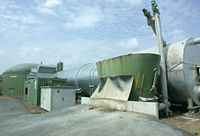
Photo from wikipedia
The anaerobic digestion technology has been established decades ago but still the commercial biogas industries are facing some challenges like process imbalance and failure of the digester, which has to… Click to show full abstract
The anaerobic digestion technology has been established decades ago but still the commercial biogas industries are facing some challenges like process imbalance and failure of the digester, which has to be addressed by monitoring and identifying early warning indicators essential in the operation and maintenance. The aim of present study is to evaluate the early warning indicators during start-up: optimization, full load, and gradual overload phases of an 18-m3 commercial food waste biogas plant. The plant was operated by applying the optimal operation limits of FOS/TAC, TVFA/TA, IA/PA (Reply’s), and BA/TA ratios in the optimization of the AD process. The plant performance was studied in terms of methane yield, reduction in OLR, HRT, VS, and COD. The plant was operated for a span of 12 months at different OLRs ranging from 0.32 kg COD/m3/day (start-up) to 2.03 kg COD/m3/day (overload) in a mesophilic condition. Results showed that performance of AD at full load, in terms of biogas yield (m3/day) and methane yield (m3 CH4/(kg VS reduced) and m3 CH4/(kg COD reduced)), was found to be average of 32.65, 0.55, and 0.57, respectively. The process imbalance was observed from day 114 to day 119 of optimization period. The values of FOS/TAC, IA/PA, and TVFA/TA ratios were detected to be slightly more than the regular values, whereas bicarbonate alkalinity (BA) was abruptly reduced to 0.37 (kg CaCO3/m3). On the other hand, intermediate alkalinity (IA) value has been increased to 3.2 (kg CaCO3/m3), which was defined as limit for process instability. The gradual overload (0.6% more VS addition for 28 days) has no significant affect on the AD process and biogas production, but methane yield was slightly decreased.
Journal Title: Biomass Conversion and Biorefinery
Year Published: 2021
Link to full text (if available)
Share on Social Media: Sign Up to like & get
recommendations!